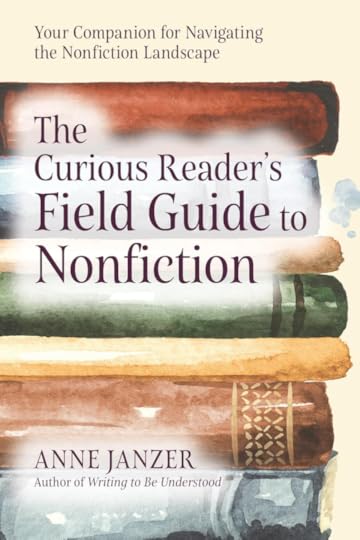Where Do the Stories Come From?

Today’s guest post is excerpted from the new book The Curious Reader’s Field Guide to Nonfiction by Anne Janzer.
I happen to believe that every person on earth is a storyteller. We are all trying to understand the story of our lives.
—Steve Almond, Truth is the Arrow, Mercy is the Bow
In a sense, all writing originates from memoir, drawing on the writer’s own perspectives, observations, and stories. Many authors (including this one) fill books and essays with personal anecdotes.
Yet as readers, we often want to see ourselves or our situations reflected in the work—especially when reading advice. If we cannot picture ourselves, we may feel unwelcome. For example, a woman reading a book filled with profiles of men may feel subtly excluded, even if she doesn’t consciously realize the reason.
Nonfiction writers have to decide where to collect their stories and how much to rely on their personal experience.
For journalistic exposés, memoir, history, or other narrative nonfiction, the subject determines the story and characters. For books that explain or inspire, authors have a wide menu of options for choosing stories to support their ideas.
Personal experienceWriters’ own experiences are readily available, so they show up frequently. Sharing personal stories creates a sense of connection between reader and writer.
Early in the book Subtract: The Untapped Science of Less, Leidy Klotz tells the story of the moment he conceived of his area of study. He was using blocks to build a bridge with his young son. They needed to connect towers of different heights. While he automatically reached for a block to add to the shorter tower, his son simply removed a block from the taller tower. And in that moment, Klotz had an epiphany: if we want simpler, lower-impact designs, we must confront our knee-jerk instinct to solve every problem through addition. The story highlights the concept that anchors the entire book. (He also turned it into an experiment that confirmed the broader bias for addition.)
Other people’s storiesMany authors find stories through original research: interviewing subjects, surveying people, and otherwise being out in the world, physically or virtually. When they share stories of non-famous people, writers must introduce us to the characters. That can be a challenge.
Some authors are brilliant at drawing these characters—read any of Michael Lewis’s books about finance to meet people who come to life on the page. But not all writers are as adept. If we cannot feel a connection to or visualize the people, the stories will not carry as much power as they could.
How widely does the writer reach in gathering these stories? If they all come from the author’s own networks, readers outside those networks may feel excluded. For example, books about entrepreneurship that only profile venture-backed tech businesses may not not land with aspiring entrepreneurs in retail or service businesses.
Stories from the news, history, legends, or fiction Amazon • Bookshop
Amazon • BookshopStories embedded in popular culture are easy to access and often familiar to readers. But there’s a risk that the reader may have encountered them before. So many business books have relied on Steve Jobs’s story that it has become stale—an ironic legacy for such an innovative man.
Nonfiction books often combine stories from all of these sources. The right balance depends on what effect the author hopes the stories, in aggregate, will have on the reader.
We feel seen when the story represents people like us.We gain fresh perspectives when the stories highlight people different from us.We feel connected when writers share personal stories we can relate to.The choice of stories itself tells a story.
Jane Friedman
- Jane Friedman's profile
- 1882 followers



